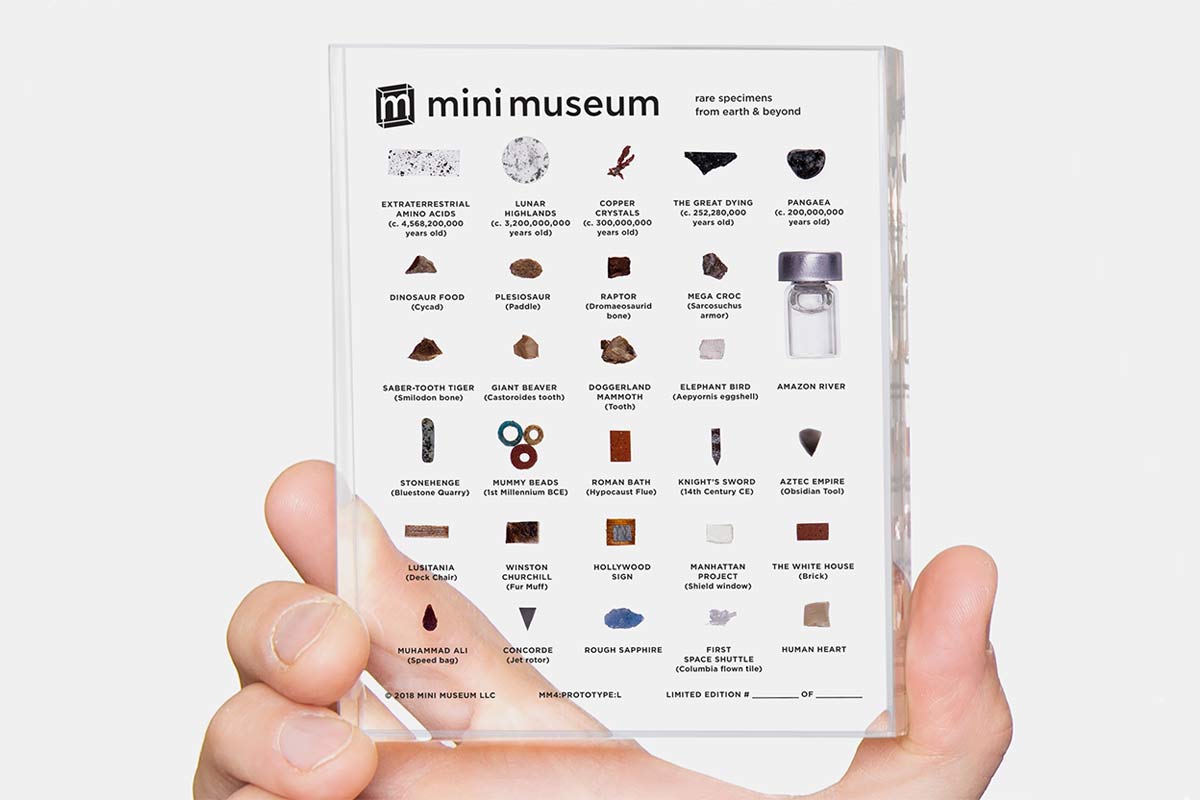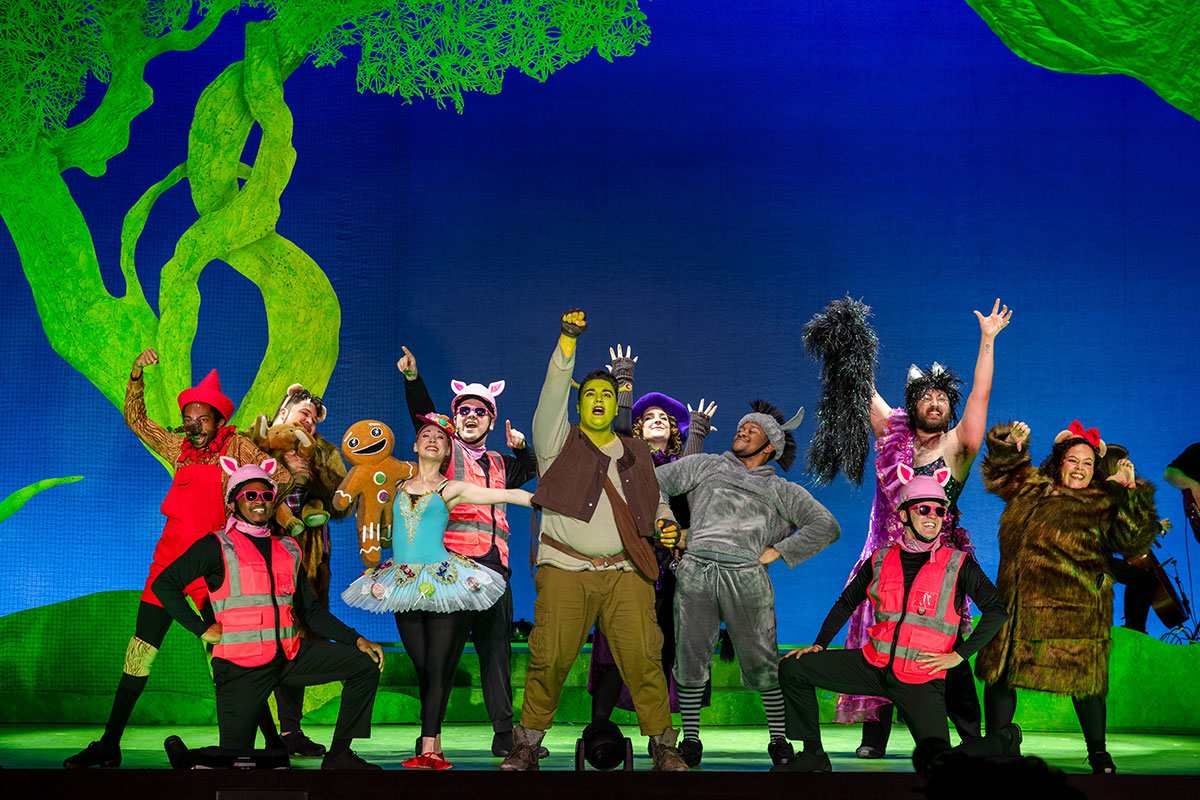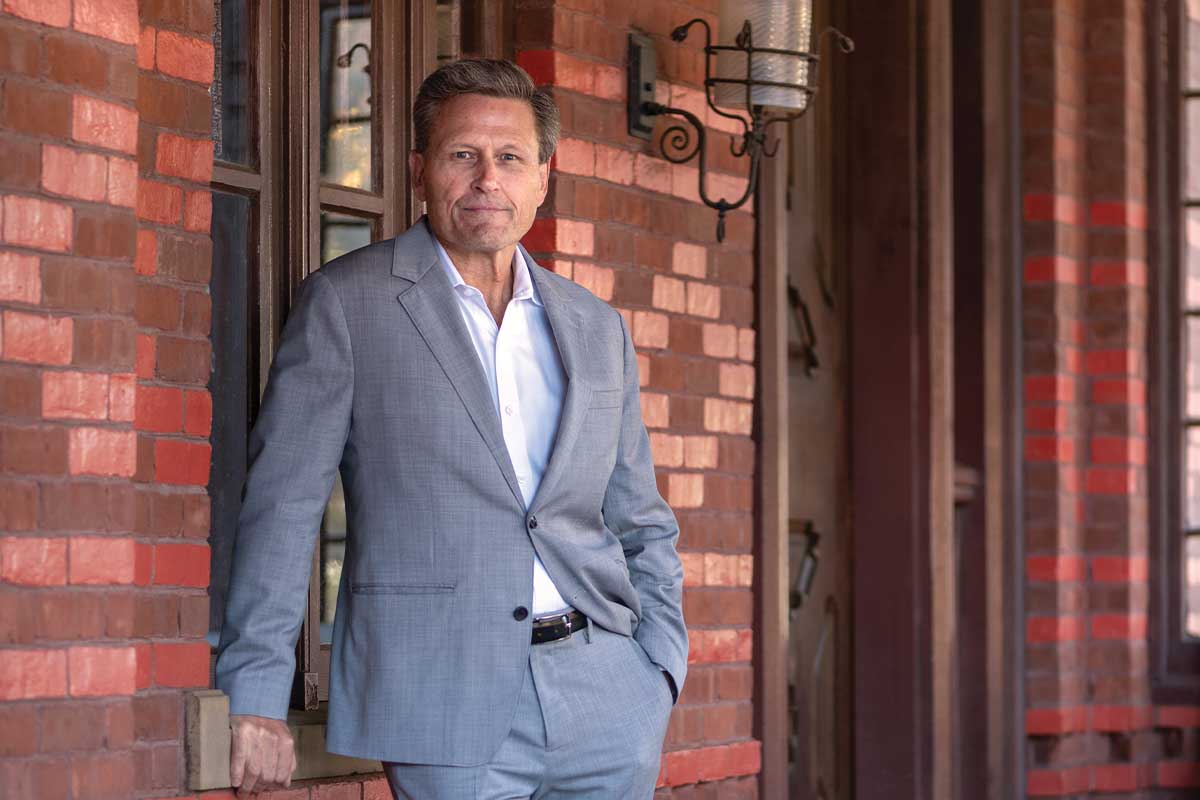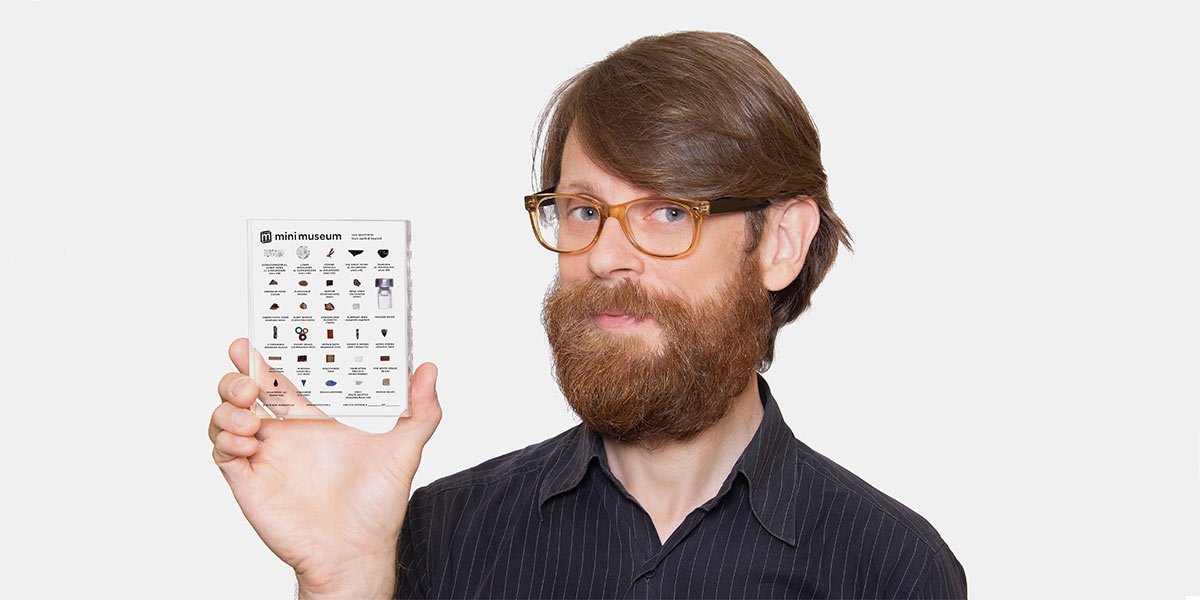
“I love what I do,” says Hans Fex, creator and chief curator of the Mini Museum. “I love the people I work with. I’m the one who gets to travel all over the place, especially if it involves a lot of inoculations or if it’s hazardous.”
A modern-day explorer, Fex travels the world in search of rare artifacts. His most recent travels, for example, had him navigating the Amazon River in Peru. While there, he collected 12 gallons of water near Iquitos, Peru, which is said to be the largest city on Earth only accessible by air or water. But you won’t find his piece of the Amazon tucked away in a building somewhere. Instead, Fex’s globe-trotting travels are turned into miniature collections that you can carry with you.
The Mini Museum doesn’t have an address—because it’s not a museum in the traditional sense. Each individual “Mini Museum” is a collection of extremely rare and unusual artifacts from around the world and across the universe of time. The artifacts in a Mini
Museum are carefully encased in safe, non-toxic acrylic that creates a handcrafted, individually numbered limited edition block that’s about 5x4x1-inches.
It’s “small enough to put in your pocket or display on your desktop, mantle or coffee table,” Fex says.
Fex and his team have created three versions of the Mini Museum, containing all manner of artifacts and oddities in miniature form. In July 2018, Fex announced work on a fourth Mini Museum, which is now available to order. The Amazon water he collected will be divided down to the milliliter, placed in vials and take its place as part of the latest Mini Museum.
A TINY WORLD OF WONDER
This idea for a tiny world of wonder germinated when Fex was a youngster in second grade in 1977. His late father, Dr. Jörgen Fex, was a research scientist and a director at the National Institutes of Health. Prior to that, he was docent professor at the Karolinska Institute; a senior research fellow at the John Curtin School of Medical Research in Canberra, Australia; a professor of anatomy and physiology at Indiana University; and acting scientific director of the National Institute on Deafness and Other Communication Disorders. He was a polyglot who spoke Italian, French, Swedish and German.
Every scientific magazine was at arm’s reach and his father had an abundance of artifacts in his office and at home. As residents of Northern Virginia, the family frequented the Smithsonian museums and saw dinosaur bones, meteorites and other scientific and historic objects almost every weekend.
Dr. Fex was a specialist on hearing and deafness research, and at NIH he was the head of the Laboratory of Otolaryngology, working with contemporaries from around the world. When the younger Fex was 7 years old, Dr. Fex went to Malta and returned with some artifacts that he embedded into an epoxy resin. The young Fex had never seen that before, but thought it was beautiful. It also ignited the “aha!” moment of how to contain little bits of his collection in a tiny space and show it to his friends.
This was a way to share the treasures with “other children. I soon thought about children from all walks of life: every color and every country around the world,” he recalls.
Science wasn’t his only love. Fex says he started designing toys as a child and when he was with ThinkGeek, a Fairfax-based toy and apparel company, he worked on a T-shirt that doubled as a toy. Unlike shirts that have a picture of a drum kit, the ThinkGeek shirt had seven different drum pad sounds that you beat with your hand and, voila, you had music. It was washable, once you removed the power pack and drum decal. Before your parents tried to deny you access to the shirt, the volume was adjustable.
Fex kept the treasures-in-resin idea in the back of his head as he grew. He says he “met scientists, museum curators, astronauts and other adventurers. With their help and the backing of thousands of people around the world, I’ve been able to assemble an incredible collection” of interesting souvenirs from all over. With his network of connections in the scientific community and his design skills gained at ThinkGeek, Fex decided to finally launch his long-held dream.
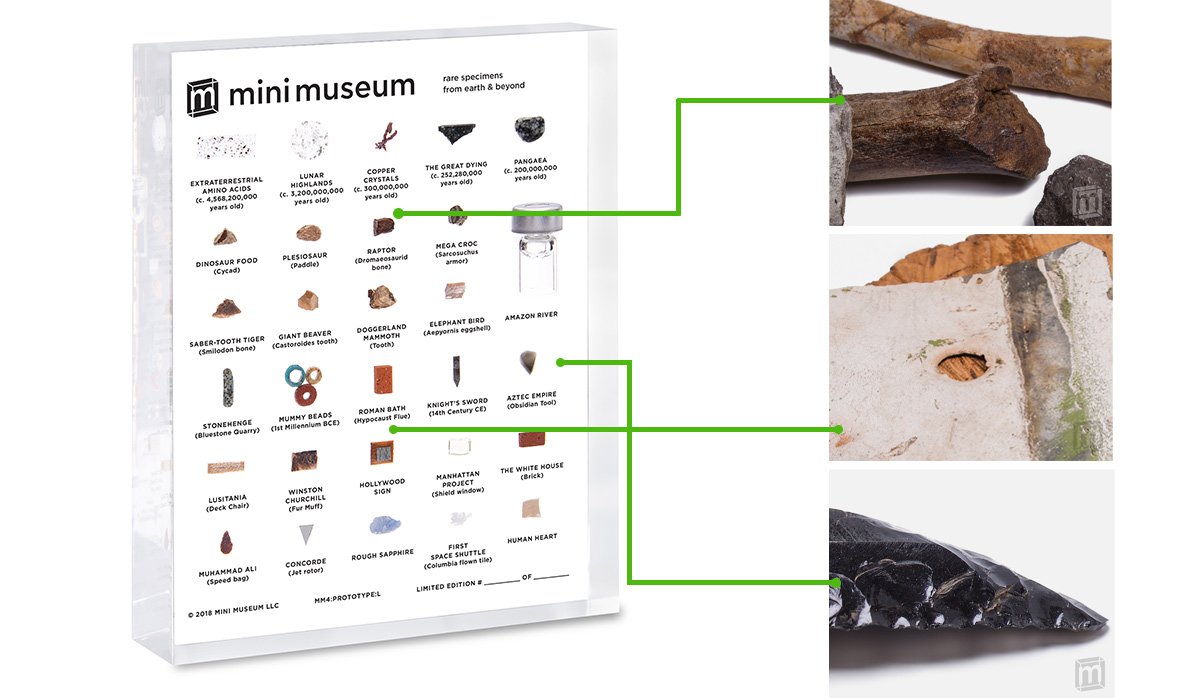
THE MINI MUSEUM IS BORN
Fex teamed up with partners Jamie Grove and Willie Vadnais, whom he had worked with at ThinkGeek, to turn the Mini Museum into a reality. They anticipated they’d make and sell a few hundred. But when they announced their idea on Kickstarter, the idea quickly built buzz and they raised an eye-popping $750,000 in the first eight days. The total soared to more than $1.2 million by the time they closed the offers. That put the first Mini Museum in the top 10 Kickstarter campaigns. Each Mini Museum iteration starts with a Kickstarter and all have performed impressively.
With that incredible financial backing, Fex, Grove and Vadnais released the first Mini Museum and other forms of the tiny collections of curiosities in 2014.
It’s a team effort designing, making and marketing these diminutive museums. Fex works on product design and, of course, finding the artifacts at the source. Grove and Vadnais work on research and production.
“It’s a dream today for us,” says Grove. “We’re doing things we enjoy and things we love.”
SOURCING SPECIMENS
Each Mini Museum runs the gamut of fascinating pieces that you can put in your pocket. Previous museums have contained a piece of one of Steve Jobs’ black turtleneck shirts, sold by his personal assistant at public auction. Fex’s winning bid for this iconic computer lore was $8,000. A moon tree (a tree started from seed during the voyage) was given to the team and used in the second Mini Museum.
The most expensive specimen, and the most popular so far, was a piece of kapton foil from the Apollo 11 command module that cost them more than $10,000 and they had to wait 10 years before it came up for auction in 2007. The foil provided thermal protection for the astronauts aboard the capsule and belonged to Buzz Aldrin. This one is available for sale as an individual specimen, divided into 1×1-mm portions, not as part of a Mini Museum collection.
When it comes to favorites—“that’s like asking which is your favorite child,” says Grove—he likes the geological stuff. “They tell a deep story about the planet. People also love fossils and dinosaurs. The samurai sword was an amazing piece to see,” Grove says. “We took a 14th century tool and used a 21st century tool to create little bread slices of the blade and then made it smaller to attach it to a piece of fabric that belonged to a samurai. The royal wedding cake from Prince Charles and Diana is another favorite.”
The trio amasses items ranging from coal from the Titanic to human brain tissue (from a laboratory in Russia that supplies plastinated humans for exhibits worldwide) to a T-Rex tooth (collected on private ranch land and thought to have been shed while the animal was feeding), a piece of the London Bridge (the one from the 19th century that moved to Lake Havasu City, Arizona, in 1968), an Egyptian mummy wrap, a dinosaur egg, a foundation brick from Abraham Lincoln’s house, hair from a woolly mammoth, a lunar meteorite, a sample from the San Andreas fault and a piece of the first transatlantic cable.
Deciding what goes into a Mini Museum is a collaborative effort among them, their employees and people from the outside world. “Mostly,” says Fex, “it starts with something that’s going to inspire people to somehow or other learn from this specimen that will make their life better by thinking about the item.”
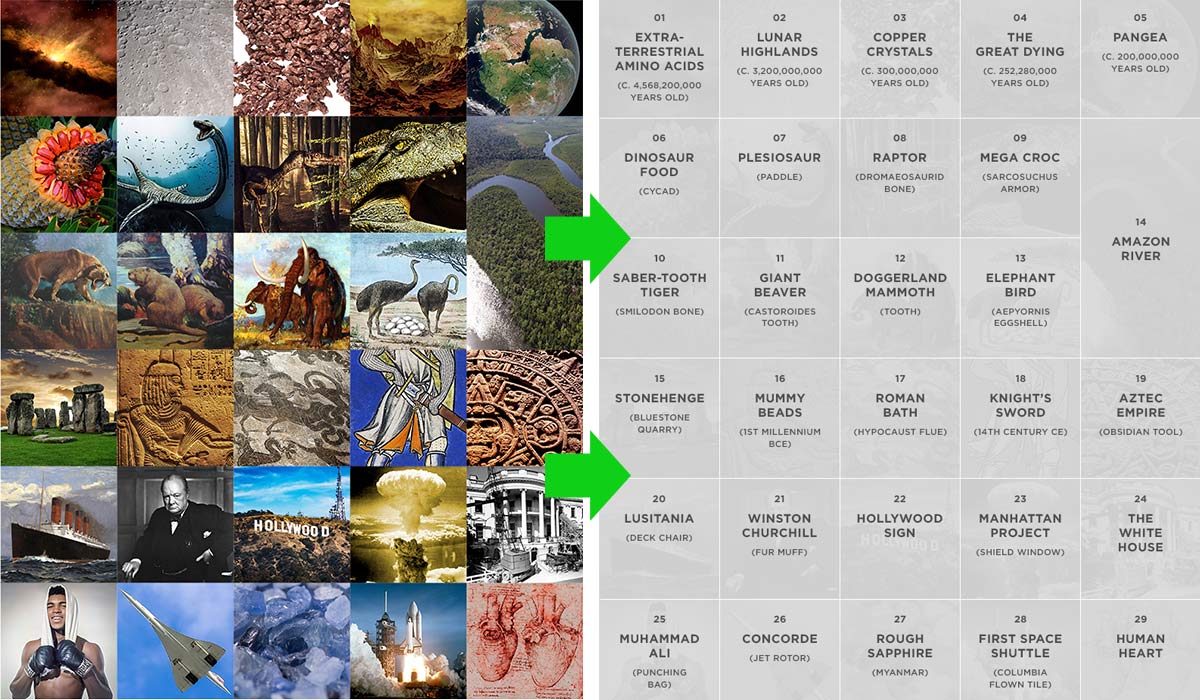
CURATING THE COLLECTION
Fex and the guys love when people contact them with a suggestion for something to be included. “I think of this as a basic item,” say Fex, holding one of his Mini Museum blocks in his hand. “It’s just a block with things in it. But, it’s so interactive to me.
“As an example,” Fex says, “Hank Ebes, an art dealer from Australia, has a love affair with fossils and things that show how long the earth has been here. He suggested we include part of an aepyornis egg.”
The aepyornis (aka the elephant bird) from the island of Madagascar was a huge flightless bird that probably became extinct in the past century. According to Fex, its prey realized they couldn’t attack the bird, but they could attack the eggs, said to be the largest laid in Earth’s history. “Eat enough of the eggs, rich in protein, and the bird becomes extinct.”
The general formula for selecting items for a Mini Museum, Fex says, “is brainstorming about what kind of things would be exciting, generally starting with something as old as our solar system and then we want to end on a human element. Sometimes it’s an actual
specimen from a human element to remind people that we’re really just parts of history.”
They’ve already started collecting ideas for Mini Museum 5, which they hope to release in 2019. Grove says they have a long wish list for the next one, but they don’t announce it because “if we told you, we wouldn’t be able to get it. An auction at Christie’s or smaller auction house would bump up the price of an item.” The items range from “pieces from other planetary bodies to personal specimens from iconic people and pop culture. Pete Townsend of The Who, famous for smashing guitars, would produce a perfect item for us because the guitar is already broken. We’d love to get something more modern, from SpaceX, but they haven’t released anything.”
Each iconic item, says Fex, is thoroughly vetted to make sure it is authentic and that “we have to know it was done legally and ethically.”
The team sets aside a number of the museums to provide to schools, libraries and other organizations that work with children all over the world through their Mini Museum Education Donation Program, including Navy Elementary in Fairfax and Kings Glen Elementary in Springfield locally.
The Mini Museum’s popularity has even gone global. People from 100 countries have purchased the museums.
In other words, Fex and friends have made the rarities available to the public via these Mini Museums. They were years ahead of the current downsizing trend. Thousands of people all around the world have bought the Mini Museums and other items.
“The reality is we’re humbled by our backers and the support we’ve gotten from all over the world. It’s truly amazing to us this outpouring of love,” says Fex. “We’re grateful every single day. That’s the way we feel about it. People send us pictures of their children with the Mini Museum from all over the world.”

